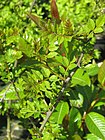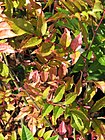Note: This is a project under development. The articles on this wiki are just being initiated and broadly incomplete. You can Help creating new pages.
Zanthoxylum armatum
Zanthoxylum armatum varies in habit from a prickly, deciduous to evergreen shrub, woody climber or small tree growing up to 5 metres tall. The plant is mainly gathered from the wild for use as a condiment and medicine, as well as for various other commodities. It is sometimes also cultivated and is grown as a hedge in northern India.
Contents
[hide]- 1 Uses
- 2 Parts Used
- 3 Chemical Composition
- 4 Common names
- 5 Properties
- 6 Habit
- 7 Identification
- 8 List of Ayurvedic medicine in which the herb is used
- 9 Where to get the saplings
- 10 Mode of Propagation
- 11 How to plant/cultivate
- 12 Commonly seen growing in areas
- 13 Photo Gallery
- 14 References
- 15 External Links
Uses
Fevers, Dyspepsia, Cholera, Abscesses, Arthritis, Bruises, Gastritis, Swellings, Toothache, Cuts, Wounds.[1]
Parts Used
Chemical Composition
Chemical studies on the seeds of Zanthoxylum armatum (Rutaceae) led to the isolation of two new phenolic constituents characterized as 3-methoxy-11-hydroxy-6,8-dimethylcarboxylate biphenyl and 3,5,6,7-tetrahydroxy-3 etc.[2]
Common names
| Language | Common name |
|---|---|
| Kannada | Jimmi |
| Hindi | Tejphal |
| Malayalam | |
| Tamil | Timur |
| Telugu | Konda-Kasimi |
| Marathi | |
| Gujarathi | |
| Punjabi | |
| Kashmiri | |
| Sanskrit | |
| English | Winged Prickly Ash, Prickly ash |
Properties
Reference: Dravya - Substance, Rasa - Taste, Guna - Qualities, Veerya - Potency, Vipaka - Post-digesion effect, Karma - Pharmacological activity, Prabhava - Therepeutics.
Dravya
Rasa
Guna
Veerya
Vipaka
Karma
Prabhava
Habit
Identification
Leaf
| Kind | Shape | Feature |
|---|---|---|
Flower
| Type | Size | Color and composition | Stamen | More information |
|---|---|---|---|---|
| {{{5}}} |
Fruit
| Type | Size | Mass | Appearance | Seeds | More information |
|---|---|---|---|---|---|
Other features
List of Ayurvedic medicine in which the herb is used
Where to get the saplings
Mode of Propagation
Seeds, Cuttings of half-ripe wood, Root cuttings.
How to plant/cultivate
A plant with a wide environmental tolerance, being found from the temperate to tropical zones.[5]
Commonly seen growing in areas
Rain forests, Thickets, On open slopes, Rock ledges.
Photo Gallery
References
- Jump up ↑ Indian Medicinal Plants by C.P.Khare
- Jump up ↑ Chemical constituents
- Jump up ↑ Cite error: Invalid
<ref>tag; no text was provided for refs namedCommon names - Jump up ↑ [Morphology]
- Jump up ↑ Cultivation
External Links
- Pages with reference errors
- Ayurvedic Herbs known to be helpful to treat Fevers
- Ayurvedic Herbs known to be helpful to treat Dyspepsia
- Ayurvedic Herbs known to be helpful to treat Cholera
- Ayurvedic Herbs known to be helpful to treat Abscesses
- Ayurvedic Herbs known to be helpful to treat Arthritis
- Ayurvedic Herbs known to be helpful to treat Bruises
- Ayurvedic Herbs known to be helpful to treat Gastritis
- Ayurvedic Herbs known to be helpful to treat Swellings
- Ayurvedic Herbs known to be helpful to treat Toothache
- Ayurvedic Herbs known to be helpful to treat Cuts
- Ayurvedic Herbs known to be helpful to treat Wounds
- Herbs with Seeds used in medicine
- Herbs with Young leaves used in medicine
- Herbs with common name in Kannada
- Herbs with common name in Hindi
- Herbs with common name in Tamil
- Herbs with common name in Telugu
- Herbs with common name in English
- Habit - Semi-deciduous Shrub
- Index of Plants which can be propagated by Seeds
- Index of Plants which can be propagated by Cuttings of half-ripe wood
- Index of Plants which can be propagated by Root cuttings
- Herbs that are commonly seen in the region of Rain forests
- Herbs that are commonly seen in the region of Thickets
- Herbs that are commonly seen in the region of On open slopes
- Herbs that are commonly seen in the region of Rock ledges
- Herbs










